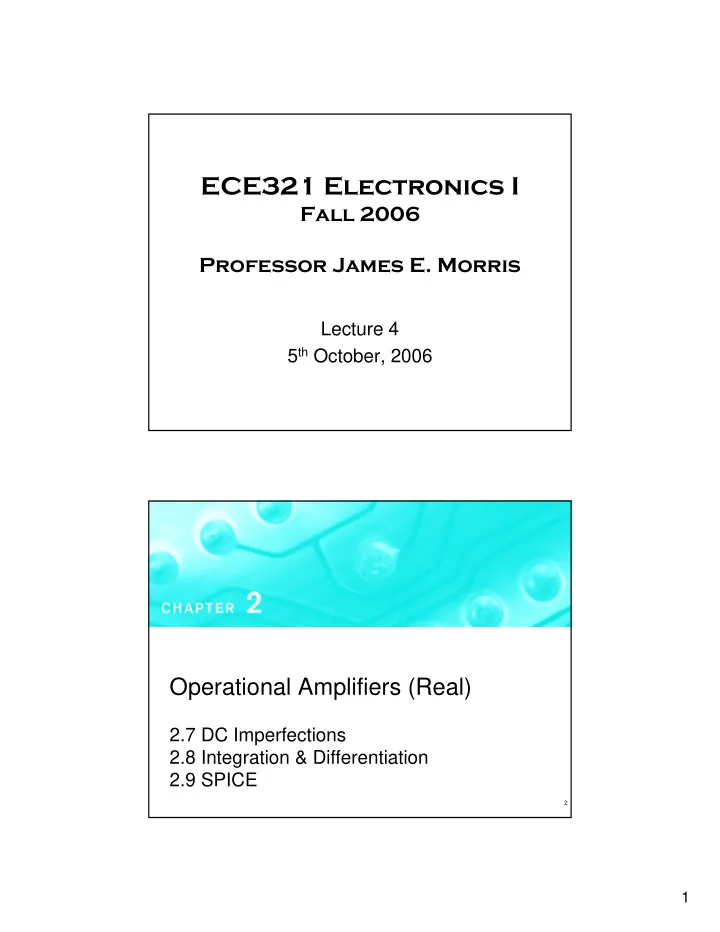

ECE321 Electronics I Fall 2006 Professor James E. Morris Lecture 4 5 th October, 2006 Operational Amplifiers (Real) 2.7 DC Imperfections 2.8 Integration & Differentiation 2.9 SPICE 2 1
Figure 2.28 Circuit model for an op amp with input offset voltage V OS . Figure E2.23 Transfer characteristic of an op amp with V OS = 5 mV. 2
Figure 2.29 Evaluating the output dc offset voltage due to V OS in a closed-loop amplifier. Figure 2.30 The output dc offset voltage of an op amp can be trimmed to zero by connecting a potentiometer to the two offset-nulling terminals. The wiper of the potentiometer is connected to the negative supply of the op amp. 3
Figure 2.31 (a) A capacitively coupled inverting amplifier, and (b) the equivalent circuit for determining its dc output offset voltage V O . Figure 2.32 The op-amp input bias currents represented by two current sources I B 1 and I B 2 . 4
Figure 2.33 Analysis of the closed-loop amplifier, taking into account the input bias currents. Figure 2.34 Reducing the effect of the input bias currents by introducing a resistor R 3 . 5
Figure 2.35 In an ac-coupled amplifier the dc resistance seen by the inverting terminal is R 2 ; hence R 3 is chosen equal to R 2 . Figure 2.36 Illustrating the need for a continuous dc path for each of the op-amp input terminals. Specifically, note that the amplifier will not work without resistor R 3 . 6
Figure 2.37 The inverting configuration with general impedances in the feedback and the feed-in paths. Figure 2.38 Circuit for Example 2.6. 7
Figure 2.39 (a) The Miller or inverting integrator. (b) Frequency response of the integrator. Figure 2.40 Determining the effect of the op-amp input offset voltage V OS on the Miller integrator circuit. Note that since the output rises with time, the op amp eventually saturates. 8
Figure 2.41 Effect of the op-amp input bias and offset currents on the performance of the Miller integrator circuit. Figure 2.42 The Miller integrator with a large resistance R F connected in parallel with C in order to provide negative feedback and hence finite gain at dc. 9
Figure 2.43 Waveforms for Example 2.7: (a) Input pulse. (b) Output linear ramp of ideal integrator with time constant of 0.1 ms. (c) Output exponential ramp with resistor R F connected across integrator capacitor. Figure 2.44 (a) A differentiator. (b) Frequency response of a differentiator with a time-constant CR . 10
Figure 2.45 A linear macromodel used to model the finite gain and bandwidth of an internally compensated op amp. Figure 2.46 A comprehensive linear macromodel of an internally compensated op amp. 11
Figure 2.47 Frequency response of the closed-loop amplifier in Example 2.8. Figure 2.48 Step response of the closed-loop amplifier in Example 2.8. 12
Figure 2.49 Simulating the frequency response of the µ A741 op-amp in Example 2.9. Figure 2.50 Frequency response of the µ A741 op amp in Example 2.9. 13
Figure 2.51 Circuit for determining the slew rate of the µ A741 op amp in Example 2.9. Figure 2.52 Square-wave response of the µ A741 op amp connected in the unity-gain configuration shown in Fig. 2.51. 14
Recommend
More recommend